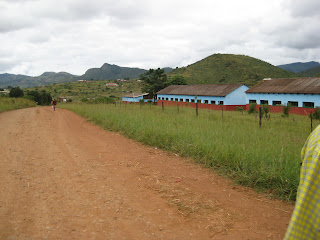 |
| Chris and his family |
 |
| This is taken from Tszingwe. The rounded peak just to the right of the road is where Chris goes to get his stone. |
 |
| Chris with a rough cut elephant sculpture |
Then he uses three different grades of sandpaper and water to smooth the sculptures.
At that point, he boils each sculpture in water. The heat makes the substances he puts on the sculpture in the next step stick better.
Once the rock is very hot, he applies a coat of black or dark brown shoe polish to the sculpture. He lets that dry and the rock cool before he adds a second coat. If he wants to bring out the natural color of the stone, he may brush it with melted candle wax first, and then add just a little shoe polish, which gives the rock a shine without coloring it deeply.
Chris’s grandfather was known as a very good stone carver and taught Chris this trade when Chris was a young man. He used to make a reasonable living at it when there were more tourists in this part of Zimbabwe, but now he is branching out into buying and reselling food items and hiring out his truck to carry people’s maize crops from the field because he cannot sell enough sculptures in this economy to support his family.



